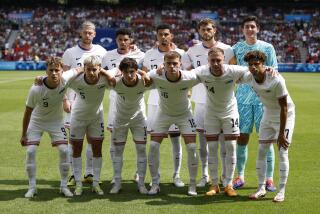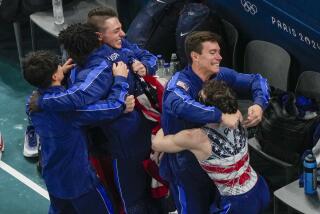Countdown to the Winter Olympics / Lillehammer â94 : Bodine Is the Latest to Give Shimer a Push : Bobsled: NASCAR racerâs efforts give U.S. a shot at a medal.
LILLEHAMMER, Norway â There was a time, before and during the 1992 Winter Olympics, when Brian Shimer became known as the driver to the stars--Herschel Walker, Willie Gault and Edwin Moses.
Shimer could never be sure who was in his lineup as the U.S. Bobsled Federation campaigned for stronger, swifter and more illustrious athletes to help attract sponsors and propel Shimer down the hill faster.
Ultimately, push came to shove:
--Moses stormed out in a controversy over selection procedure.
--Gault failed to qualify in final â92 push trials.
--Walker joined Shimer in USA I at the Winter Games in Albertville, France, but his inexperience contributed to a seventh-place finish, and he was benched for the four-man event, in which a U.S. team driven by Randy Will finished ninth.
Shimer, 31, a Floridian who played football at Morehead State, approaches these Games as driver of USA I in both the two-man and four-man events.
Walker, Gault and Moses are gone. Shimer has basically operated with the same pushers and brakemen for two seasons, experiencing unprecedented success in the winter of 1992-93 and major disappointment this season while preparing for Olympic competition.
The United States has not won an Olympic medal in bobsled since 1956, and it is impossible to measure Shimerâs chances off the disparity of the past two seasons.
The only certainty is that much of the attention will continue to focus on the sled itself.
For the first time since â56, the United States will use U.S.-made sleds--courtesy, for the most part, of NASCAR driver Geoff Bodine, who became interested while watching the Albertville Games on television and has since spent $130,000 to seed development and production of six Bo-Dyn sleds and stimulate interest in what is known as the Bobsled Project, raising $500,000.
âWin or lose (in the Winter Olympics), the project is a success,â Bodine said.
Translated: U.S. sledders, often operating in the past with European hand-me-downs or incurring years of debt to buy their own German- or Italian-made models--Shimer spent $20,000 on a two-man sled--will not have to shop elsewhere or shop, period. The financial foundation should enable them to drive in the comparative lap of luxury, with the best of U.S. technology.
âIt was ridiculous, depressing,â Bodine said of a situation in which U.S. Olympians were often sent out with second-rate equipment and the pressure of a second mortgage.
He was exposed to it after the â92 Games, during which he kept thinking that he could do a better driving job than the ones he was seeing on TV. He went to Lake Placid, N.Y., to prove it and, he said, âscared myself to death.â
Winner of more than $7 million on the NASCAR circuit, Bodine started from halfway down the hill and ultimately left a sled borrowed from driver Bruce Rosselli resembling the sourest lemon on a used-car lot.
âI was shocked to find that it was kind of a piece of junk to start with, but I told Bruce Iâd build him a new one,â Bodine said. âIâm sure he didnât believe me. I know theyâd all heard it before.â
In conjunction with Bob Cuneo at Chassis Dynamics in Oxford, Conn., where Bodine had built some of his race cars, Bodine proved to be a man of his word and wallet.
The sleds, incorporating the latest in computer technology and ongoing input from the sledders themselves, have been delivered with a pit crew and IBM support team, freeing the athletes from the often time-consuming before-and-after dirty work.
Said Shimer: âIâll take the ice at 90 m.p.h. anytime. Itâs the three or four hours working on the sled after a full day of training that wears you down.â
The first Bo-Dyn was scheduled to make its debut in a World Cup race last Feb. 24. Test runs convinced Shimer, âIt was the difference between a Yugo and Porsche,â but it was disqualified for technical reasons by the European-dominated International Rules Committee before the races. Cuneo made the required changes, and the sled passed inspection in July, when Shimer unofficially blistered the Lillehammer track record in the World Cup tour trials, enhancing Olympic optimism and the euphoria generated by Shimerâs World Cup championship of the previous winter.
That euphoria, however, soon began to deflate.
Shimer and two-man partner Randy Jones, a former Duke football captain, finished no better than seventh in four World Cup races, and his four-man team of Jones, former Iowa track all-American Karlos Kirby and former Indiana State hurdler Bryan Leturgez finished no better than 10th.
The desultory performance by the entire U.S. team during almost two months in Europe prompted the federation to rework the January schedule.
Instead of returning to Europe for the last of five World Cup races and remaining there to conduct U.S. Olympic trials and final preparations, the team has spent the last four weeks in trials and training at the 1988 Olympic facilities in Calgary, Canada, where there has been a rebirth of optimism amid significantly improving start times plus a fresh physical and mental outlook.
âIâd say that weâre back where we were at the start of last season,â Shimer said, referring to his World Cup championship campaign. âHopefully, weâll continue to progress now. I feel better about our situation. We still have time to get to where we want to be.â
The Olympic two-man competition doesnât begin until Feb. 19. Shimer said there has been considerable improvement since early December, when he questioned the dedication and desire of his teammates in an interview with The Times. Then, he suggested that they were riding the World Cup success of the previous winter, seemingly satisfied merely to go to the Olympics instead of working hard toward winning a medal, a view endorsed at that time by Coach Joey Kilburn.
âI was upset, and justifiably so,â the intense Shimer said. âThe attitude is better now, but the focus should have been there from the start. Of course, there were a lot of distractions, and that contributed to it. The way the World Cup schedule was this (season), we were really burnt out by the time we got back from Europe. We hadnât eaten well, slept well or been able to train well, we were over there so long.â
Shimer was also troubled by a leg injury that affected start times throughout the season and ultimately prompted him to bring in a neuromuscular specialist to maximize his training during Januaryâs Calgary encampment. Then, too, there was the debut of the Bo-Dyns, which reacted differently to the different conditions of different courses, requiring mid-competition adjustment and an ongoing process of fine tuning.
It was recently decided, in fact, that the Bo-Dyn sleds to be driven here by Shimer and Jim Herberich will use the footing and axle from federation-owned Italian sleds because they were found to be more flexible than the original Bo-Dyn steel.
âThe drawback (to the sleds) is that we havenât had enough time to do as much research as we would have liked, but (the developers and crew) have worked great under pressure,â Shimer said. âTheyâve been receptive to every suggestion. I mean, in 1988 the federation probably blew a million dollars hiring scientists to build a new sled, but they never talked with the athletes. It was amazing the thing even went down hill. If these sleds arenât faster than what weâve been using, it canât be done.â
Bodine was told it couldnât be done when he first proposed his project. He was told about the hours and money wasted on previous projects and received little encouragement from the U.S. Olympic Committee or the U.S. Bobsled Federation, whose executive director, Matt Roy, now says the sleds have become âa rallying force.â
âPeople told us we were nuts,â Bodine said. âNow I travel around the country and am overwhelmed by the interest. I couldnât be prouder.
âAs racers, we know it should be impossible to walk in and beat a country thatâs been building sleds or cars forever, but thatâs where we are (with the bobsled project) in less than two years. We have a chance, and that makes it even more special.
âI mean, I always wanted to be an Olympic athlete but was too small and too slow, so that to feel now like Iâm part of it, to have done something for the country, that everyone seems to have gotten behind, is a real honor.â
Bodine will be driving at Daytona Beach, Fla., when the American-made sleds carrying his name race on the Olympic track at Hunderfossen.
It is the third Winter Olympics for Shimer, who said he probably would be teaching industrial arts and coaching high school wrestling and football if he hadnât responded to a federation letter seeking a few good men years ago.
How did a Floridian--there is now the incongruity of a hometown Naples Bobsled Club to help raise funds and cover his debts--take to the snow, ice and daunting challenge of a bobsled run?
âI donât know that I had ever considered myself a daredevil, but I liked the speed and challenge,â Shimer said.
A pattern of controversy and corruption has plagued the U.S. Bobsled Federationâs pursuit of the ultimate dream, a return to the Olympic medal stand. Walker, Moses and Gault represented $250,000 to the federation in a sponsorship deal with McDonaldâs, but when all three failed to make the team, McDonaldâs patriotic gesture was to cut its contribution to $30,000.
The federation eventually decided it couldnât run athletes in on a whim, that continuity and training were critical. Now a U.S. bobsledder must compete on the World Cup circuit to be eligible for the Olympics.
âIf Herschel had made bobsledding his No. 1 sport, he probably would have become the best pusher in the world, but we didnât have even one race together prior to the (â92) Olympics,â Shimer said. âIt was assumed weâd have the fastest start in the world, but it didnât happen because it comes down to technique and timing. Itâs like running me into the Super Bowl. You canât just climb into a sled and be the fastest down the hill.
âWeâve always had superior athletes to the Europeans, but they produce the better starts because they stay together and work on it for years at a time. This has been the first time in my eight years that the same team has trained together for more than a year.â
Shimer remains confident that this continuity will produce a medal. If so, Geoff Bodine will have to be looked upon as an equally driving force.
More to Read
Go beyond the scoreboard
Get the latest on L.A.'s teams in the daily Sports Report newsletter.
You may occasionally receive promotional content from the Los Angeles Times.






